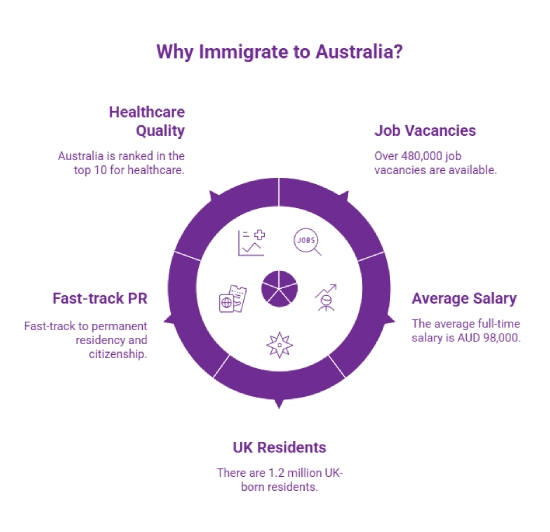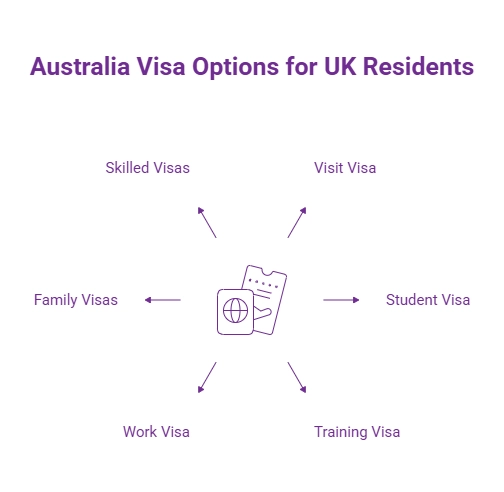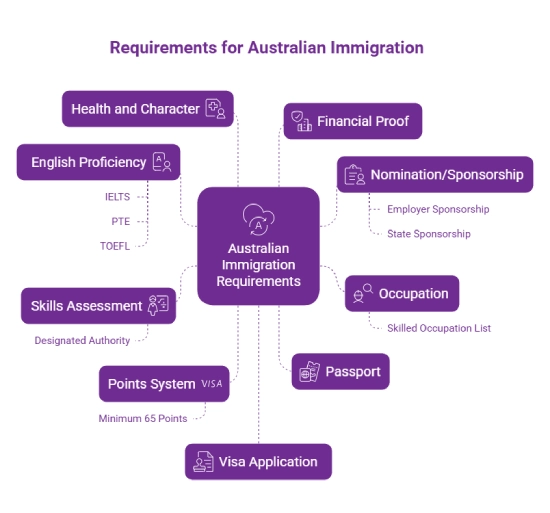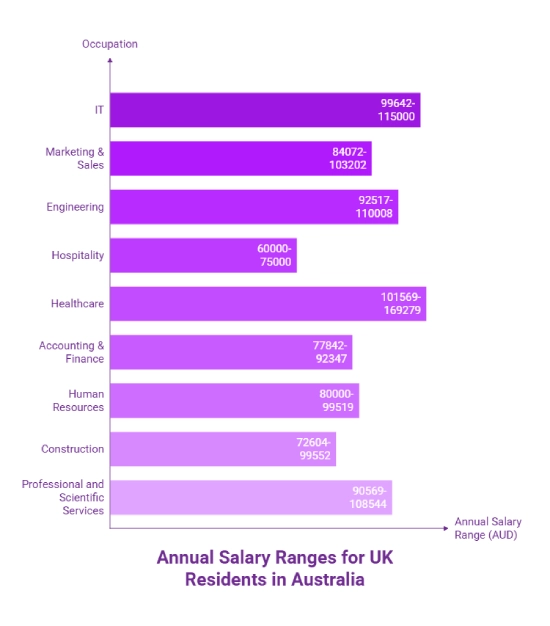Sign up for a free expert consultation
Generally, for Australia immigration, the major requirement is a minimum score of 65 points for an Australian work visa. However, if your score is between 80-85, there are more chances for Australian immigration along with a PR visa. The score is calculated based on age, education, qualification, work experience, adaptability, etc.
Educational Profile
Professional Profile
IELTS score
Skill assessment by certified authorities in Australia
References & legal documentation
Australian Employment documentation

Australia remains a top destination for UK nationals seeking long-term opportunities abroad. With strong demand for skilled professionals across sectors, high average salaries, and a well-established British expat community, the country offers both economic and lifestyle benefits. Australia’s world-class healthcare system, high quality of life, and clear pathway to permanent residency and citizenship make it an ideal choice for those planning to build a future overseas. Whether you're pursuing career growth or a better work-life balance, Australia offers a welcoming and rewarding environment for UK migrants.
*Want to migrate to Australia? Sign up with Y-Axis to guide you with the process.
Australia offers a range of visa options for visitors, students, professionals, and families based on purpose and eligibility.

Points-tested visas for invited skilled workers through SkillSelect. Subclasses 189 and 190 grant permanent residence; 491 is a provisional regional visa that can lead to PR if post-grant criteria are met. Applicants typically need a suitable skills assessment, an eligible occupation, and to meet the points threshold at time of invitation.
Visas that let partners, parents, children, and other eligible relatives of Australian citizens, permanent residents, or eligible New Zealand citizens live in Australia. Requirements, stages (temporary/permanent), and processing times vary by subclass; all applicants must meet health and character checks.
A permanent residence pathway where an Australian employer nominates a skilled worker. Streams include Direct Entry, Temporary Residence Transition, and Labour Agreement, each with stream-specific skill, English and (where relevant) age criteria alongside an approved nomination.
The former Global Talent visa is closed to new applications. Its replacement, the National Innovation visa (858), is a permanent, invitation-only visa for people with an internationally recognized record of exceptional and outstanding achievement in priority fields; candidates submit an EOI and may be invited to apply.
The Working Holiday visa program allows young adults to travel and work in Australia for up to 12 months. It gives an opportunity to fund your holiday through short-term employment while experiencing Australian culture and lifestyle.
Migrating to Australia offers a well-rounded lifestyle, strong career prospects, and a clear path to long-term settlement for individuals and families.
To immigrate to Australia, applicants must meet specific criteria based on the visa stream they are applying under.
The general eligibility criteria for Australian immigration is as follows:
The table below has breakdown of the categories and points allotted for each in the points-based system:
| Category | Maximum Points |
| Age (25-32 years) | 30 points |
| English proficiency (8 bands) | 20 points |
| Work Experience outside Australia (8-10 years) | 15 points |
| Work Experience in Australia (8-10 years) | 20 points |
| Education (outside Australia) – Doctorate degree | 20 points |
| Niche skills such as Doctorate or master’s degree by research in Australia | 10 points |
| Study in a regional area | 5 points |
| Accredited in community language | 5 points |
| Professional year in a skilled program in Australia | 5 points |
| State sponsorship (190 visa) | 5 points |
| Skilled spouse or de facto partner (Age, Skills & English language requirements to be met) | 10 points |
| Spouse or de facto partner with ‘competent English’ (No need to meet Skills requirement or age factor) | 5 points |
| Applicants without a spouse or de facto partner or where a spouse is an Australia citizen or PR holder | 10 points |
| Relative or regional sponsorship (491 visa) | 15 points |
*Want to check your eligibility to Australia? Try the FREE Y-Axis Australia immigration points calculator and get an instant score!
The requirements for Australian immigration are as follows:

If you are a UK resident planning to settle in Australia permanently, the General Skilled Migration (GSM) program is one of the most common routes.
Given below is a step-by-step process to get permanent residency in Australia:
Step 1: Check Your Eligibility
Ensure your occupation is listed on Australia's Skilled Occupation List and that you meet the age, English language, education, and work experience requirements.
Step 2: Get a Skills Assessment
Apply for a skills assessment through the relevant assessing authority for your occupation. A positive result is mandatory to proceed.
Step 3: Take an English Language Test
Demonstrate your English proficiency through accepted tests like IELTS, PTE, or TOEFL if required for your visa type.
Step 4: Calculate Your Points
Use the Department of Home Affairs’ points calculator. You need at least 65 points to be eligible for most skilled visas.
Step 5: Submit an Expression of Interest (EOI)
Create a profile in SkillSelect and submit your Expression of Interest for a skilled visa such as Subclass 189, 190, or 491.
Step 6: Receive a Visa Invitation
If your EOI is selected, you’ll receive an invitation to apply for the visa. Invitations are issued based on your points and occupation demand.
Step 7: Apply for the Visa
Complete your visa application online through the ImmiAccount portal within 60 days of receiving the invitation.
Step 8: Wait for the visa status
The Department of Home Affairs will assess your application. If approved, you will be granted a permanent residence visa.
The table below has complete details of the average processing time for different Australian visa types:
| Type of Australia Visa | Processing time |
| Visit visa | 20 to 30 days |
| Student visa | 1 to 3 months |
| Training visa | 3 to 4 months |
| Work visa | 2 to 8 months |
| Family and partner visas | 23 to 30 months |
| Skilled visas | 6.5 to 8 months |
| PR visa | 8 months to 10 months |
The table below has complete details of the processing fee for the three major Australian PR visa pathways:
| Category | Fee Effective from 1st July 24 |
| Subclass 189 | Main Applicant -- AUD 4765 |
| Applicant above 18 yrs -- AUD 2385 | |
| Applicant below 18 yrs -- AUD 1195 | |
| Subclass 190 | Main Applicant -- AUD 4770 |
| Applicant above 18 yrs -- AUD 2385 | |
| Applicant below 18 yrs -- AUD 1190 | |
| Subclass 491 | Main Applicant -- AUD 4770 |
| Applicant above 18 yrs -- AUD 2385 | |
| Applicant below 18 yrs -- AUD 1190 |
| Spending category (ABS) | Average weekly cost (AUD) |
| Current housing costs (selected dwelling) | $279 |
| Domestic fuel & power | $41 |
| Food & non-alcoholic beverages | $237 |
| Alcoholic beverages | $32 |
| Tobacco products | $13 |
| Clothing & footwear | $44 |
| Household furnishings & equipment | $58 |
| Household services & operation | $45 |
| Medical care & health expenses | $82 |
| Transport | $207 |
| Communication | $47 |
| Recreation | $172 |
| Education | $44 |
| Personal care | $29 |
| Miscellaneous goods & services | $97 |
| Total goods & services | $1,425 / week |
Australia offers several permanent visa options that allow individuals and families to live, work, and settle in the country indefinitely. The most popular routes include skilled visas under the General Skilled Migration (GSM) program and family sponsorship visas. These visa types not only provide long-term residence but also open the door to Australian citizenship over time.
As a permanent resident of Australia, you are entitled to many of the same benefits as Australian citizens, including:
*Want to apply for an Australian PR visa? Let Y-Axis guide you with the process.
Australia offers several structured routes for individuals seeking to live, work, or settle permanently in the country. These key immigration pathways include:
Australia’s Skilled Migration program is designed to attract qualified professionals from around the world to meet the country’s labour market needs. This points-based immigration system offers a pathway to permanent residency for individuals with in-demand skills, work experience, and strong English language proficiency.
Eligible applicants must meet specific criteria including age, qualifications, work experience, English ability, and occupation relevance as outlined in the Skilled Occupation List (SOL). Points are awarded based on these factors, and candidates with higher scores are more likely to receive an invitation to apply for a skilled visa.
Popular visa subclasses under the Skilled Migration program include:
Skilled migration is one of the most sought-after immigration pathways, offering a direct route to permanent residency and, eventually, Australian citizenship. The program not only supports Australia's economic growth but also provides long-term stability and opportunities for skilled migrants and their families.
Australia offers a strong job market with high demand for skilled professionals across sectors like healthcare, IT, engineering, and construction. Competitive salaries, a stable economy, and a high quality of life make it an attractive destination for global talent.
| Occupation | Annual Salary in (AUD) |
| IT | $99,642 – $ 115, 000 |
| Marketing & Sales | $84,072 – $103,202 |
| Engineering | $92,517 – $110,008 |
| Hospitality | $60,000 – $75,000 |
| Healthcare | $101,569- $169279 |
| Accounting & Finance | $77,842 – $92,347 |
| Human Resources | $80,000 – $99,519 |
| Construction | $72,604 – $99,552 |
| Professional and Scientific Services | $90,569 – $108,544 |

*Looking to work in Australia? Avail Y-Axis Job Search services to assist you with the job search process.
The Australia Immigration Planning Levels for 2024–25 outline the number of permanent visas to be granted across skilled, family, and special eligibility streams. The program is designed to address labour shortages, support economic growth, and reunite families.
| Skill Stream Visa | |
| Visa Category | 2024-25 Planning Levels |
| Employer-Sponsored | 44,000 |
| Skilled Independent | 16,900 |
| State/Territory Nominated | 33,000 |
| Regional | 33,000 |
| Business Innovation & Investment | 1,000 |
| Global Talent Independent | 4,000 |
| Distinguished Talent | 300 |
| Skill Total | 1,32,200 |
| Family Stream Visa | |
| Visa Category | 2024-25 Planning Levels |
| Partner | 40,500 |
| Parent | 8,500 |
| Child | 3,000 |
| Other Family | 500 |
| Family Total | 52,500 |
| Special Category Visa | |
| Special Eligibility | 300 |
| Grand Total | 1,85,000 |
The table below has a complete overview of the estimated employment growth in Australia from 2023 to 2026:
| Sector | Projected Job Opportunities (2023 to 2026) |
| Health Care and Social Assistance | 301000 |
| Professional, Scientific and Technical Services | 172400 |
| Education and Training | 149600 |
| Construction | 118800 |
| Accommodation and Food Services | 108900 |
| Transport, Postal and Warehousing | 62100 |
| Administrative and Support Services | 59700 |
| Retail Trade | 51900 |
A skills assessment is a crucial part of the Australian immigration process for skilled visa applicants. It verifies that your qualifications and work experience meet Australian standards for your nominated occupation. The assessment must be completed by an approved assessing authority relevant to your occupation and is often required before you can apply for a skilled visa.
Key factors considered during a skills assessment include:
Note: Each occupation has a specific assessing authority, and the process, fees, and documentation requirements can vary. A positive skills assessment is usually valid for 2–3 years and is mandatory for most skilled migration pathways such as Subclass 189, 190, or 491.
Finding accommodation
Healthcare & Medicare
Banking & finances
Path to citizenship
Y-Axis is the leading immigration consultant for individuals looking to migrate to Australia. Our end-to-end support with the immigration process ensures that you make the right decision at every step. We guide you with:
Explore what Global Citizens have to say about Y-Axis in shaping their future
Australia PR visa
Uday Seshadri giving feedback after rece
Read More...
Australia PR visa
Subhashini giving feedback after receivi
Read More...
Australia PR visa
Varun Mathur giving feedback after recei
Read More...
To obtain Australian PR from the UK, most people follow the General Skilled Migration (GSM) process:
Step 1: Confirm your occupation is on the Skilled Occupation List and meet age, English, and experience requirements.
Step 2: Obtain a positive skills assessment from the relevant assessing authority.
Step 3: Submit an Expression of Interest (EOI) via SkillSelect and secure at least 65 points.
Step 4: Receive an invitation to apply for visas like Subclass 189, 190 or 491.
Step 5: Lodge your application online with supporting documents and undergo health and character checks.
The general list of requirements to migrate to Australia are as follows:
Processing times depend on the visa category, completeness of the application, and current demand.
The table below has details of the processing times for the most common visa types for UK residents applying to migrate to Australia:
| Type of Australia Visa | Processing time |
| Visit visa | 20 to 30 days |
| Student visa | 1 to 3 months |
| Training visa | 3 to 4 months |
| Work visa | 2 to 8 months |
| Family and partner visas | 23 to 30 months |
| Skilled visas | 6.5 to 8 months |
| PR visa | 8 months to 10 months |
The cost of moving to Australia from the UK varies based on visa type, family size, and relocation needs. Some of the most common expenditure typically include visa fees, health checks, flights, and shipping.
The table below has a complete breakdown of the factors involved in the costs of moving to Australia from the UK:
| Factors | Cost |
| Skills Assessment Costs | AUD 500 to 1,000 or UKP 275 to 550 |
| Authentication Fees | AUD 100 to 200 or UKP 55 to 110 |
| Visa Application Fee | AUD 4,640 or UKP 2,417 for subclass 189 |
| Visa Assistance | AUD 2,000 to 4,000 or UKP 1,100 to 2,200 (agency) |
| Mandatory Medical Check | AUD 300 to 600 or UKP 165 to 330 per person |
| Shipping | AUD 6,000 to 12,000 or UKP 3,300 to 6,600 |
| Rental Deposits & Advance Rent | AUD 4,500 or UKP 2,475 |
| Police Certificate | AUD 50 to 100 or UKP 28 to 55 |
| Health Insurance | AUD 250 to 400 or UKP 140 to 220 |
| Flights from the UK to Australia | AUD 1,500 to 3,000 or UKP 825 to 1,650 for 0061 1-way ticket |
To immigrate to Australia through the General Skilled Migration (GSM) pathway, you must score at least 65 points on the Australian points-based system. This is the minimum threshold required to be eligible to submit an Expression of Interest (EOI) in SkillSelect. However, meeting the minimum does not guarantee an invitation to apply, as candidates with higher scores are often prioritised.
Yes, you can travel to Australia while your PR visa is being processed, but only if you hold a valid temporary visa. If you’re applying from within Australia and hold a Bridging Visa A (BVA), you must apply for a Bridging Visa B (BVB) to leave and re-enter the country legally. The BVB allows travel during a specified period while your PR application is under review. Without it, your application may be considered withdrawn.
Yes, it is possible to immigrate to Australia from the UK after the age of 50, even if you are retired. However, your options for obtaining a Permanent Residence (PR) visa may be more limited compared to younger applicants. Australia does not currently offer a direct retirement visa pathway for permanent residency. However, there are select visa routes that older individuals may consider based on their circumstances.
Yes, you can bring your car and pets to Australia from the UK, but strict rules apply. To ship a car, you’ll need a Vehicle Import Approval before shipping, and your car must meet Australia’s safety and environmental standards. You’ll also need to pay import duties, taxes, and ensure the vehicle is thoroughly cleaned.
For pets, only cats and dogs from approved countries like the UK are allowed. You must apply for an import permit, ensure all vaccinations and health checks are done, and your pet must complete at least 10 days of quarantine on arrival. Using approved relocation services is highly recommended.
Here’s a step-by-step guide to applying for permanent residency in Australia:
Step 1: Check your eligibility based on age, skills, occupation, language proficiency, and health requirements.
Step 2: Choose the appropriate visa pathway—Skilled Migration (Subclass 189/190/491), Family, or Business visa.
Step 3: Complete a skills assessment through the relevant assessing authority for your occupation.
Step 4: Submit an Expression of Interest (EOI) via SkillSelect if applying through a points-tested skilled visa.
Step 5: Receive an invitation to apply (if applicable) and submit your visa application online.
Step 6: Complete health and character checks and await a decision from the Department of Home Affairs.
Moving from the UK to Australia is relatively straightforward, especially due to strong bilateral ties and similar legal systems. Australia offers multiple visa options such as skilled migration, family sponsorship, and student visas. UK citizens often meet the eligibility criteria, particularly for skilled visas, due to high English proficiency and relevant qualifications. However, the process involves careful documentation, points-based assessments, and meeting health and character requirements. While not automatic, with the right visa pathway and proper planning, many UK applicants successfully migrate. Using professional immigration services can also streamline the process and improve approval chances.
Yes, UK citizens can move to Australia, but they require a valid visa to do so. The most common long-term pathways include skilled migration visas (such as Subclass 189, 190, or 491), employer-sponsored visas (Subclass 482), and family visas for those with relatives in Australia. For retirees or young travellers, options like the Working Holiday Visa or Partner Visa are also available. While UK citizens enjoy close ties with Australia, free movement is not permitted; an approved visa application is mandatory for residence, work, or study. Permanent residency (PR) can eventually lead to Australian citizenship.
Australia has a strong demand for skilled professionals, and job opportunities vary by sector and region. Healthcare, engineering, information technology, construction, and education are consistently listed on the Skilled Occupation List. UK citizens with recognized qualifications and relevant experience often find good prospects, especially in metropolitan areas like Sydney, Melbourne, and Brisbane, or regional areas offering PR incentives. The mining and energy sectors also provide opportunities in Western Australia and Queensland. Since the Australian labour market is merit-based, overseas qualifications must be accredited where required. UK migrants benefit from strong English language skills, which ease workforce integration.
Yes, most skilled migration visas to Australia have an upper age limit of 45 years at the time of invitation. This applies to visas such as Subclass 189 (Skilled Independent), Subclass 190 (State Nominated), and Subclass 491 (Regional). However, employer-sponsored visas (e.g., Subclass 482) may allow applicants above 45 in specific high-demand occupations, and Partner or Parent visas generally have no strict age cap. The Working Holiday Visa, popular with UK citizens, has an age limit of 18 to 35 years. Therefore, while age can be a factor, there are still viable options for older applicants through family or employer sponsorship.
Yes, Australia allows dual citizenship. Individuals can hold Australian citizenship alongside the citizenship of another country, provided that the other nation also permits dual nationality. Australians acquiring another citizenship do not automatically lose their Australian status, and foreign nationals becoming Australians may retain their original citizenship if allowed by their home country’s laws. Dual citizenship grants people the benefits and rights of both nations, such as living, working, and accessing services in Australia, while also maintaining ties abroad. However, it may involve responsibilities like taxation or military service in both countries.